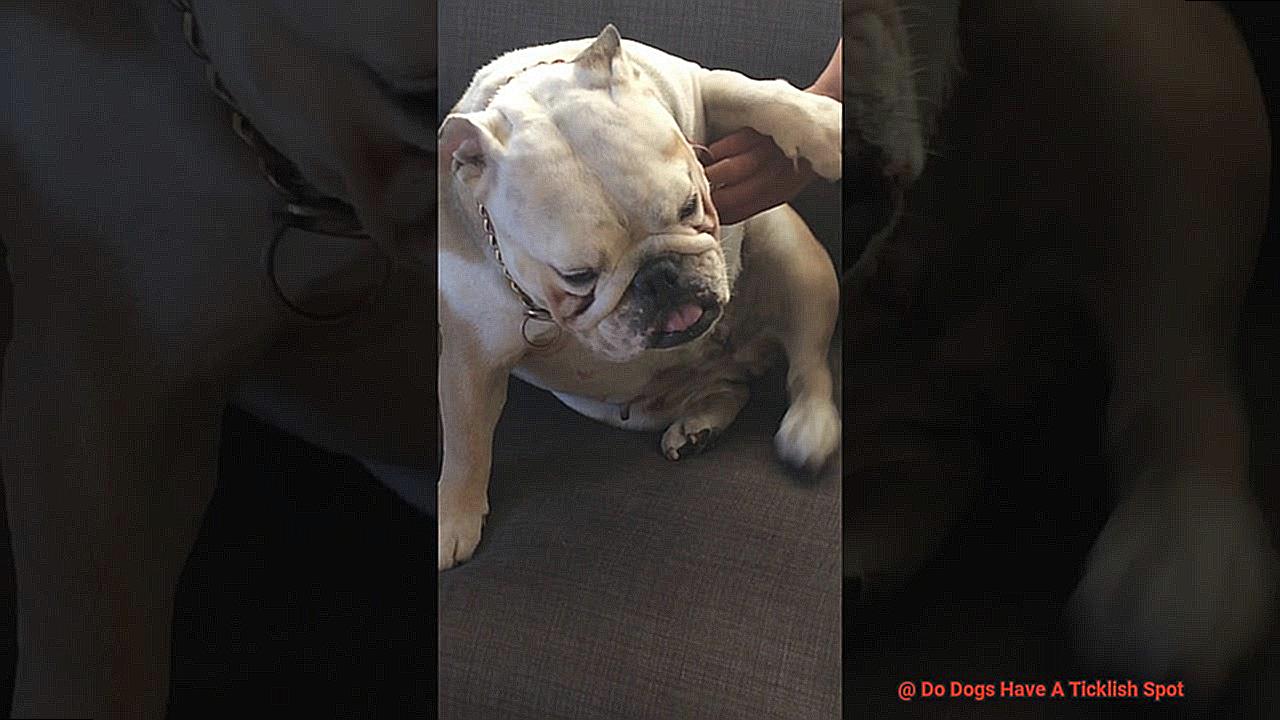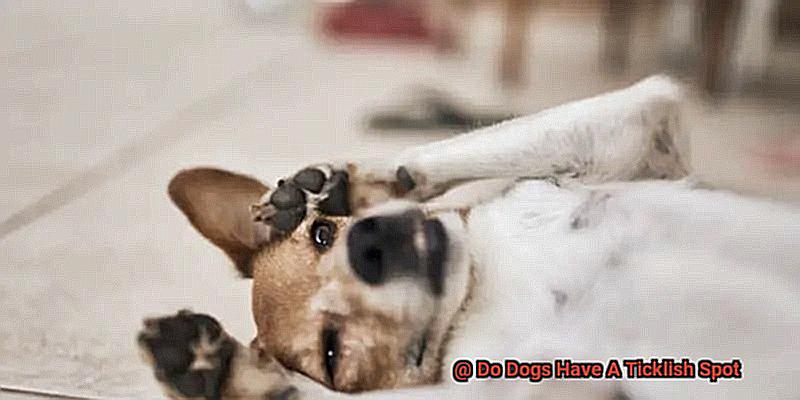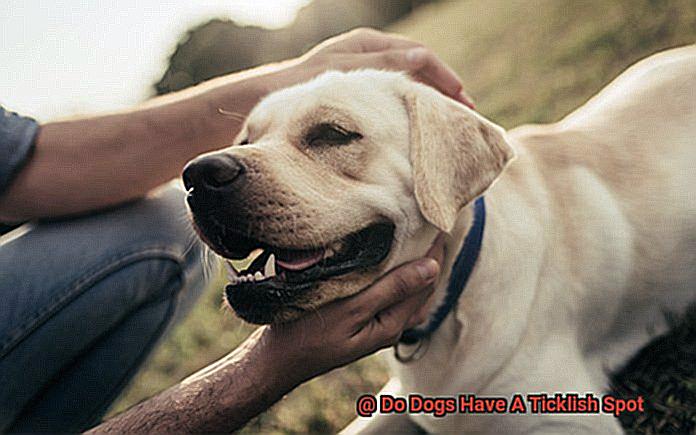Do Dogs Have A Ticklish Spot?
It’s that mischievous sensation that sends humans into fits of laughter and uncontrollable squirming. But have you ever wondered if our furry, four-legged companions can experience this tantalizing tickle too? I mean, can you even imagine a dog giggling? It might seem like a comically absurd notion at first, but as any devoted dog owner knows, there are moments when our beloved pets react with an intriguing mix of laughter-like sounds and twitching movements. So, in this blog post, we’re about to embark on an exhilarating journey into the uncharted territory of canine ticklishness. Buckle up and get ready to be amazed, puzzled, and thoroughly entertained as we peel back the layers of curiosity to uncover whether dogs truly possess a ticklish spot. Get those tails wagging because things are about to get tickly.
Do Dogs Have a Ticklish Spot?
Contents
- 1 Do Dogs Have a Ticklish Spot?
- 2 Common Areas on Dogs That Are Sensitive to Touch
- 3 How to Determine If Your Dog Is Enjoying Being Touched
- 4 Signs of Pleasure in Dogs When Touched
- 5 Signs of Discomfort in Dogs When Touched
- 6 Tips for Interacting With Your Dog in a Positive Way
- 7 Understanding the Difference Between Tickling and Grooming
- 8 Conclusion
In this article, we will explore the ticklish side of French bulldogs, discuss common sensitive areas, and provide tips on how to approach them safely.
Ticklish Spots on French Bulldogs:
- Belly: Many French bulldogs enjoy having their bellies tickled. When gently stimulated in this area, they may respond with playful reactions such as kicking their legs or rolling onto their back.
- Back: The back is another sensitive area for French bulldogs. Light scratching or stroking along their spine can often elicit a pleasurable response, with some dogs arching their backs or leaning into the touch.
- Paws: French bulldogs’ paws are known to be sensitive, making them prone to ticklish sensations. Tickling between the pads or giving them a gentle paw massage can lead to adorable twitching or wagging responses.
- Ears: Dogs with long ears, like French bulldogs, may have a ticklish spot at the base of their ears. Gentle rubbing or scratching in this area can be enjoyable for them and may even earn you some happy ear flops.
Approaching Tickling Safely:
While some French bulldogs may enjoy being tickled, it’s important to approach it safely and respectfully. Here are a few tips:
- Observe Body Language: Pay attention to your French bulldog’s body language and reactions when touching sensitive areas. Look for signs of pleasure such as wagging tail, relaxed posture, or happy vocalizations. Conversely, if your dog shows signs of discomfort, such as trying to move away, yelping, or displaying anxiety, it’s best to stop and respect their boundaries.
- Respect Individual Preferences: Just like humans, each French bulldog is unique and may have specific preferences when it comes to touch. Some may enjoy belly rubs, while others may find it uncomfortable. Take the time to understand and respect your dog’s individual preferences to provide them with a positive and enjoyable experience.
- Be Gentle: When tickling or touching sensitive areas, always use a gentle touch. Avoid applying too much pressure or using rough movements as this can cause discomfort or even injury.
Common Areas on Dogs That Are Sensitive to Touch
Tickle Time: Discovering the Sensitive Spots on Your French Bulldog
French bulldogs are known for their playful and affectionate nature. As a French bulldog owner, you probably love nothing more than making your furry friend laugh and wag their little tail. But have you ever wondered where those ticklish spots are? In this article, we will explore the common areas on French bulldogs that are sensitive to touch, so you can give your pup the ultimate tickle time experience.
Ears: The Gateway to Laughter
Frenchies have adorable bat-like ears that are not only cute but also incredibly sensitive. Gently rub or scratch behind their ears, and you’ll see their eyes light up with joy. Be careful though, as these delicate ears can easily get irritated or infected. Regular cleaning and maintenance is essential to keep them healthy and happy.
Paws: Tickle Their Toes
Just like humans, dogs rely on their paws for walking and running. French bulldogs have dainty little paws that are sensitive to touch, especially between their toes or pads. Give them a gentle massage or a light tickle on their paws, and watch them wiggle with delight. It’s a great way to bond with your Frenchie while also promoting healthy circulation.
Tail: Handle with Care
Ah, the wagging tail – a true symbol of a happy dog. However, the tail is also an area that can be sensitive to touch in French bulldogs. Due to its connection to the spine and the abundance of nerves, any injury or discomfort in this area can cause pain. Approach your Frenchie’s tail with caution and avoid any rough handling.
Abdomen: A Tummy That Tickles
French bulldogs are notorious for having sensitive tummies. Gently stroke their belly, and you might just trigger uncontrollable laughter. However, be aware that a sudden change in behavior or sensitivity in this area could indicate an underlying health issue. If you notice any unusual signs, consult your veterinarian.
Neck and Throat: Handle with Love
Frenchies have compact necks and adorable rolls around their throat. While these areas can be sensitive to touch, it’s important to handle them with love and care. Avoid putting too much pressure or manipulating their necks roughly. Instead, give them gentle neck scratches or soft massages to make them feel loved and relaxed.
Remember, every dog is unique, and what tickles one Frenchie might not work for another. Pay attention to your dog’s body language and reactions to ensure you’re providing the right kind of touch. Always prioritize your dog’s comfort and well-being over anything else.
How to Determine If Your Dog Is Enjoying Being Touched
As a dog owner, it’s important to understand if your furry friend is enjoying being touched. Just like humans, dogs have their own preferences when it comes to touch. In this article, we will focus on French Bulldogs and how to determine if they are enjoying being touched. We will explore their body language, facial expressions, and reactions. So, let’s dive in and learn how to decode your French Bulldog’s feelings.
Body Language:
Observing your dog’s body language is a great way to determine if they are enjoying being touched. A relaxed and happy French Bulldog will have a loose posture, wagging tail, and soft eyes. They may lean into the touch and even make gentle sounds of contentment. On the other hand, signs of stress or discomfort include tense muscles, a stiff body posture, pinned-back ears, or averting their gaze.
Facial Expressions:
Your French Bulldog’s face can tell you a lot about their feelings towards touch. A happy dog will have relaxed eyes and an open mouth, possibly panting slightly. However, if their eyes are wide and darting or their mouth is tightly closed, it could mean they are feeling uncomfortable or unhappy.
Reactions:
Pay attention to how your French Bulldog reacts to touch. Most dogs enjoy gentle strokes on their back, chest, or around their ears. They may lean into the touch or nudge you for more. However, if your dog pulls away, tries to move away from your hand, growls, or licks their lips anxiously, it is a clear sign they are not enjoying the touch.
Sensitive Areas:

French Bulldogs, like all dogs, may have specific areas that they find sensitive or ticklish. Common areas include the base of the tail, behind the ears, or under the chin. Observe your dog’s reaction when you touch these areas. If they respond positively by leaning in or showing signs of relaxation, it is likely they enjoy being touched there. Conversely, if they flinch, become tense, or try to avoid your touch in these areas, it may indicate discomfort.
Individual Preferences:
It’s important to remember that every French Bulldog is unique and may have their own preferences when it comes to being touched. Some dogs may enjoy belly rubs, while others prefer scratches behind the ears. Take the time to figure out what areas your French Bulldog enjoys being touched and respect their boundaries.
Signs of Pleasure in Dogs When Touched
French Bulldogs are known for their affectionate nature and love for physical contact. As a responsible French Bulldog owner, it’s crucial to understand and interpret the signs of pleasure in your furry friend when they are being touched. In this article, we will explore the various signals that can indicate your French Bulldog is thoroughly enjoying the touch, creating a positive experience for both you and your beloved pet.
Relaxed Body Posture:
When a French Bulldog is enjoying being touched, their body will exhibit a relaxed posture. Look out for loose muscles and a calm demeanor. You may also notice that your furry friend slightly leans into the touch, seeking more contact.
Wagging Tail:
The tail is a significant indicator of a dog’s emotional state. In the case of French Bulldogs, a wagging tail while being touched typically signifies pleasure. However, be aware that tail wagging can also indicate excitement, anxiety, or fear. Pay attention to other signs to accurately assess their happiness.
Soft Vocalizations:
French Bulldogs may express pleasure through soft sighs or moans when they are being touched in a way they enjoy. These gentle sounds are often accompanied by relaxed facial expressions and closed eyes.
Leaning Into the Touch:
If your French Bulldog leans into the touch or nudges your hand for more contact, it’s a clear indication that they are seeking further interaction and thoroughly enjoying the touch.
Slow Blinking or Squinting of Eyes:
Similar to humans closing their eyes when experiencing a pleasant sensation, French Bulldogs may exhibit slow blinking or squinting of their eyes while being touched. This behavior, often referred to as a “doggy kiss,” demonstrates trust and relaxation.
The “Happy Bow” Posture:
Some French Bulldogs may display the “happy bow” posture while being touched in a pleasurable way. This playful stance involves lowering the front end while keeping the hind end up in the air, resembling a bow. It signifies that your French Bulldog is feeling happy and comfortable.
Respecting Individual Preferences:
It’s crucial to remember that each French Bulldog is unique and may have their own preferences and sensitivities when it comes to touch. Some dogs may not enjoy being touched in certain areas or may have specific triggers that make them uncomfortable. Pay close attention to your dog’s body language and respect their boundaries.
Understanding the signs of pleasure in French Bulldogs when touched allows you to create a positive and enjoyable experience for your furry friend. By recognizing relaxed body posture, wagging tail, soft vocalizations, leaning into the touch, slow blinking or squinting of eyes, and the “happy bow” posture, you can deepen your bond with your French Bulldog and ensure their well-being during every interaction.
Signs of Discomfort in Dogs When Touched
French Bulldogs, with their adorable squishy faces and affectionate nature, are beloved pets for many. However, like all dogs, they can also experience discomfort when touched in certain ways or areas. As a French Bulldog owner, it’s essential to be able to recognize the signs of discomfort in your furry friend to ensure their well-being. Here are some key indicators to look out for:
- Tense or Stiff Body Posture: If your French Bulldog becomes rigid or tenses up when you touch a particular area, it could be a sign of discomfort. Pay close attention to their body language and observe if they try to move away from your touch.
- Excessive Licking or Scratching: Dogs instinctively try to alleviate any discomfort or irritation by licking or scratching the affected area. If your French Bulldog starts excessively licking or scratching themselves after being touched, it may indicate that they are experiencing discomfort.
- Whining or Whimpering: Vocalizations such as whining or whimpering can be an obvious sign that your French Bulldog is feeling uncomfortable when touched. This could be accompanied by other signs of distress like avoiding eye contact or turning away.
- Changes in Breathing Patterns: Watch for any changes in your French Bulldog’s breathing when you touch them. Rapid or shallow breathing can indicate stress or discomfort, especially if it occurs alongside other signs mentioned above.
Remember that every dog is unique and may have different thresholds for touch sensitivity. While some French Bulldogs may enjoy a gentle belly rub, others may find it uncomfortable. It’s crucial to respect your dog’s boundaries and adjust your touch accordingly.
If you consistently notice signs of discomfort in your French Bulldog when touched in a specific area, it’s advisable to consult with a veterinarian. They can help identify any underlying medical issues that could be causing the discomfort and provide appropriate treatment options.

Positive reinforcement can also play a significant role in helping your French Bulldog overcome any discomfort they may feel when touched. By associating gentle touch with rewards and praise, you can gradually teach them to feel more at ease and enjoy the experience.
Tips for Interacting With Your Dog in a Positive Way
French Bulldogs are known for their friendly and affectionate nature, making them wonderful companions. To foster a positive relationship with your French Bulldog, it’s essential to interact with them in a way that promotes trust, happiness, and well-being. In this article, we will discuss various tips for positive interaction with French Bulldogs.
Use Positive Reinforcement:
Positive reinforcement is a powerful tool for training and interacting with your French Bulldog. Rewarding good behavior with treats, praise, or playtime helps reinforce desired actions and encourages them to repeat those behaviors in the future. Be consistent and patient during training sessions, focusing on rewarding positive actions rather than punishing negative ones.
Clear Communication:
Effective communication is crucial when interacting with your French Bulldog. Use simple commands and gestures that they can understand easily. Speak in a calm and reassuring tone, avoiding harsh or confusing language that may confuse or intimidate them.
Socialization:
Early socialization plays a vital role in shaping your French Bulldog’s behavior and ensuring they are comfortable in various situations. Introduce them to different people, animals, and environments gradually, using positive reinforcement to make these experiences enjoyable. This helps prevent fear-based aggression or anxiety later on.
Engage in Playtime:
French Bulldogs love to play. Regular play sessions provide mental and physical stimulation while strengthening the bond between you and your furry friend. Incorporate interactive toys or games that challenge their minds, such as puzzle toys or obedience training exercises.
Respect Boundaries:
Just like humans, dogs have boundaries and personal space. Respect your French Bulldog’s boundaries by not forcing them into uncomfortable situations or overwhelming them with too much attention. Allow them to approach new people or animals at their own pace and provide a safe space where they can retreat if needed.
Establish Routine and Exercise:
French Bulldogs thrive on routine and regular exercise. Establish a consistent daily routine for feeding, walking, and playtime to give your dog a sense of stability and predictability. Take them for daily walks, engage in physical activities suitable for their energy level, and provide mental stimulation through training or puzzle toys.
Understanding the Difference Between Tickling and Grooming
French Bulldogs are known for their unique personalities and adorable antics. As a French Bulldog owner, it’s important to understand the difference between tickling and grooming to ensure that your furry friend feels comfortable and loved. Let’s explore these concepts in more detail:
Tickling: A Human Sensation
Tickling is often a pleasurable sensation for humans, but it’s important to remember that dogs have different nervous systems and sensitivities. While some French Bulldogs may enjoy a gentle tickle or rub in certain areas, others may find it uncomfortable or even irritating. Pay close attention to your dog’s body language and reactions to determine if tickling is a positive experience for them.
Grooming: A Natural Behavior
Grooming, on the other hand, is a natural behavior for dogs. It involves cleaning and maintaining their fur and skin, keeping them healthy and parasite-free. French Bulldogs may groom themselves by licking their coats or each other during social interactions. You can also assist with grooming by brushing their fur, giving them baths, and keeping their nails trimmed.
Benefits of Grooming
Grooming serves practical purposes for French Bulldogs. It helps remove dirt, dead hair, and tangles from their coats, promotes circulation, and stimulates the production of natural oils that keep their skin moisturized. Grooming also provides them with a sense of comfort and relaxation.
Respecting Boundaries
While grooming is essential, it’s crucial to approach it gently and respectfully. French Bulldogs may have specific preferences when it comes to being groomed. Forcing them into unwanted grooming sessions can cause stress or anxiety. Pay attention to their reactions and adjust your approach accordingly.
Creating a Positive Experience
Understanding the difference between tickling and grooming allows you to provide your French Bulldog with the appropriate types of touch that they find pleasurable and comforting. By observing their body language and respecting their boundaries, you can ensure that your interactions are enjoyable for both of you.
In the next section, we will explore whether French Bulldogs have specific ticklish spots and reveal the secrets to giving them the perfect belly rub. Get ready to discover more about these delightful little creatures.
Conclusion
In conclusion, dogs do have ticklish spots.
Just like humans, dogs can experience the sensation of being tickled in certain areas of their bodies. These spots are usually found on their belly, under their chin, or on their paws.
When you gently scratch or rub these areas, you may notice your dog reacting with laughter-like sounds or by squirming and wagging its tail in delight. It’s important to remember that not all dogs enjoy being tickled, so it’s crucial to observe your dog’s body language and respect their boundaries.
Tickling can be a fun way to bond with your furry friend and bring joy to both of you.




